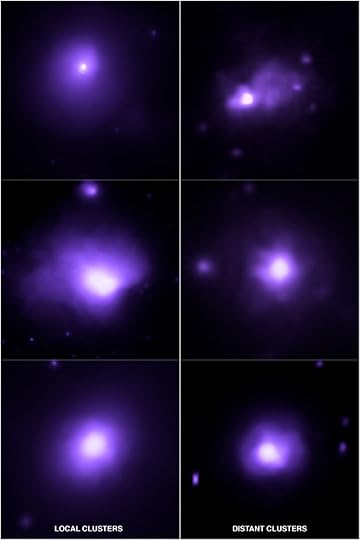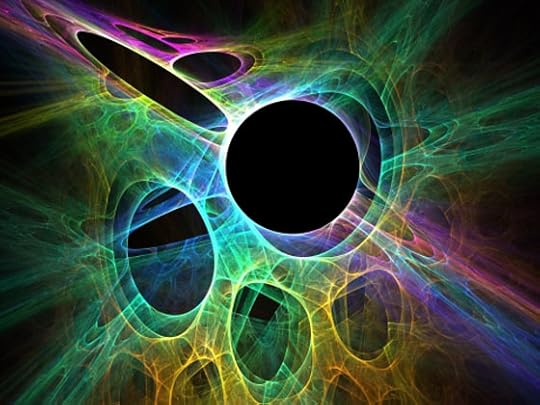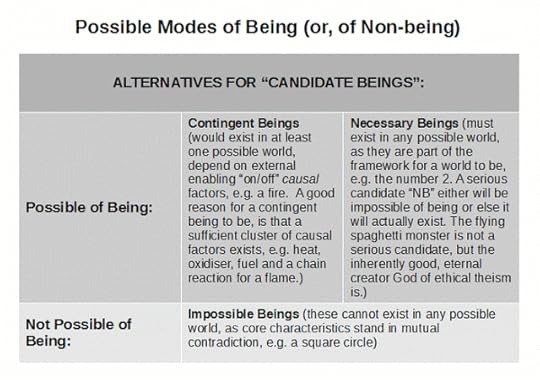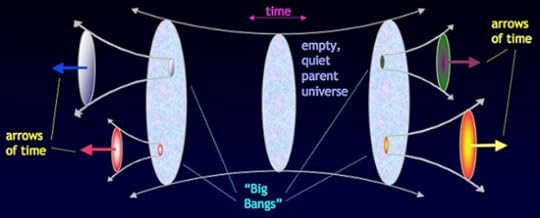Michael J. Behe's Blog, page 452
July 22, 2019
We are told that quantum Darwinism has passed its first test
One of the most remarkable ideas in this theoretical framework is that the definite properties of objects that we associate with classical physics — position and speed, say — are selected from a menu of quantum possibilities in a process loosely analogous to natural selection in evolution: The properties that survive are in some sense the “fittest.” As in natural selection, the survivors are those that make the most copies of themselves. This means that many independent observers can make measurements of a quantum system and agree on the outcome — a hallmark of classical behavior.
This idea, called quantum Darwinism (QD), explains a lot about why we experience the world the way we do rather than in the peculiar way it manifests at the scale of atoms and fundamental particles. Although aspects of the puzzle remain unresolved, QD helps heal the apparent rift between quantum and classical physics.
Philip Ball, “Quantum Darwinism, an Idea to Explain Objective Reality, Passes First Tests” at Quanta
They found that it worked in an artificial environment.
But although these studies seem consistent with QD, they can’t be taken as proof that it is the sole description for the emergence of classicality, or even that it’s wholly correct. For one thing, says Cabello, the three experiments offer only schematic versions of what a real environment consists of. What’s more, the experiments don’t cleanly rule out other ways to view the emergence of classicality.
Philip Ball, “Quantum Darwinism, an Idea to Explain Objective Reality, Passes First Tests” at Quanta
But at least they found a job for Darwinism. Wait a minute! Wasn’t there cosmic Darwinism a decade ago? Yes, here. And quantum Darwinism whistled through in 2016 too.
We shall see.
Follow UD News at Twitter!
Copyright © 2019 Uncommon Descent . This Feed is for personal non-commercial use only. If you are not reading this material in your news aggregator, the site you are looking at is guilty of copyright infringement UNLESS EXPLICIT PERMISSION OTHERWISE HAS BEEN GIVEN. Please contact legal@uncommondescent.com so we can take legal action immediately.
Plugin by Taragana
Ethan Siegel: How we can get a universe from nothing?
 possible evidence for dark energy/NASA, CXC, SAO, A.Vikhlinin et al.
possible evidence for dark energy/NASA, CXC, SAO, A.Vikhlinin et al.He brings in dark energy:
So why do we say we have a Universe that came from nothing? Because the value of dark energy may have been much higher in the distant past: before the hot Big Bang. A Universe with a very large amount of dark energy in it will behave identically to a Universe undergoing cosmic inflation. In order for inflation to end, that energy has to get converted into matter and radiation. The evidence strongly points to that happening some 13.8 billion years ago.
When it did, though, a small amount of dark energy remained behind. Why? Because the zero-point energy of the quantum fields in our Universe isn’t zero, but a finite, greater-than-zero value.
Ethan Siegel, “Ask Ethan: Can We Really Get A Universe From Nothing?” at Forbes
Well then, dark energy better exist or his theory is in trouble.
See also: What does “nothing” mean in physics? (Hugh Ross)
Follow UD News at Twitter!
Copyright © 2019 Uncommon Descent . This Feed is for personal non-commercial use only. If you are not reading this material in your news aggregator, the site you are looking at is guilty of copyright infringement UNLESS EXPLICIT PERMISSION OTHERWISE HAS BEEN GIVEN. Please contact legal@uncommondescent.com so we can take legal action immediately.
Plugin by Taragana
Why the science spin snowball can’t stop

Further to the fact that much science spin originates with the scientists, not the university hype machine or the science journalists:
Because these are all observational studies, though, we don’t know how much of this is journalists just broadcasting scientists’ spin, and how much would have happened even if the scientists stuck to the straight and narrow. Chris Chambers, who is a co-author of some of these studies, said that finding out that most media misreporting is actually because of scientists, their institutions, and journals “would make grumbling scientists look like hypocrites”. (That quote comes from a Twitter thread that’s gripping reading.)
Chambers & co went that next step, and did a randomized study. They found that hype in a press release was more likely to lead to hype in newspapers – and that a study didn’t need to be hyped to get covered. There might not be a downside to authors, journals, and universities being more cautious about what they claim.
There isn’t an evidence base, though, to show what works to reduce hyping of research results.Hilda Bastian, “Can Anything Really Stop the Science Spin Snowball?” at PLOS
The bigger problem is overlooked. The basic philosophy of the people doing the science spins the story for them. We live in the age of the space detritus that was supposed to be an extraterrestrial lightsail and the conscious plants. And the talking apes. Oh yes, and the multiverse.
The problem isn’t that people believe this stuff but that they consider it science.
Hype is a normal reaction in such an atmosphere.
See also: How naturalism rots science from the head down
Follow UD News at Twitter!
Copyright © 2019 Uncommon Descent . This Feed is for personal non-commercial use only. If you are not reading this material in your news aggregator, the site you are looking at is guilty of copyright infringement UNLESS EXPLICIT PERMISSION OTHERWISE HAS BEEN GIVEN. Please contact legal@uncommondescent.com so we can take legal action immediately.
Plugin by Taragana
July 21, 2019
The human back is, we are told, an evolutionary disaster
Everyone who lives long enough is likely to experience back pain. And the cause isn’t just aging. We have evolution to blame for a spine that’s an engineering nightmare. Cheddar Explores how our spines changed to accommodate human bipedalism.
But the real villain is hands and opposable thumbs, right? They’re part and parcel of all the bad stuff humans do. The back pain is incidental.
Naturalism (nature is all there is), often called “materialism,” is a religion that requires us to believe some strange things.
More on bipedality/bipedalism: Paleontologist: Humans walked on two legs from the beginning Carol Ward: It seems to be a behavior that was present in some of the earliest members of our branch of the family tree. It represented what was really the initial major adaptive change from any apelike creature that came before us.
Researchers: Supernova prompted humans to walk upright Funny, if bipedalism originated in a global catastrophe, that it never occurred to any other primate to resolve the problem by becoming fully bipedal. But keep thinking. Resist groupthink.
Bipedalism: Regulatory area cent.com/intelligent-design/bipedalis...” target=”another”>missing in humans
Researcher: To Understand Human Bipedalism, Stop Assuming “A Chimpanzee Starting Point”
Rough terrain caused humans to start walking upright
Early bipedalism walked no straight line
We’ve also heard that bipedalism developed so we could hit each other. Or carry infants. Or scarce resources. Or save energy. Or cool down. But mainly so we could have our hands free for whatever. (Saving eneregy and cooling down don’t really count here because lots of other methods would have worked; they just wouldn’t have freed the hands at the same time.)
See also “I’m Walkin’, Yes Indeed I’m Walkin’” But Not Because It’s Necessarily a Better Way to Get Around
Also, Design perspectives and the physiology of walking
Follow UD News at Twitter!
Copyright © 2019 Uncommon Descent . This Feed is for personal non-commercial use only. If you are not reading this material in your news aggregator, the site you are looking at is guilty of copyright infringement UNLESS EXPLICIT PERMISSION OTHERWISE HAS BEEN GIVEN. Please contact legal@uncommondescent.com so we can take legal action immediately.
Plugin by Taragana
New Scientist welcomes us to the fifth dimension
In pop science media, the End of All Things is the heat death of the universe, but some opt for stranger fates instead:
But some cosmologists think that instead of dark energy remaining forever constant, it might diminish over time, causing the universe to collapse in on itself in a big crunch, a reverse of the big bang. Others think dark energy could be growing in potency, heralding a future where the universe could expand so far so fast that the fabric of space-time starts to tear itself apart. This outcome is called the big rip.
Anil Ananthaswamy, “Welcome to the 5th dimension: Our universe’s radical new fate” at New Scientist
At New Scientist, you’d have to find out about an even stranger proposed fate, the fifth dimension. You’d have to pay to find out from them. Here re some free sources on the fifth dimension:
A model from string theory:
An article published in the journal “Physical Review Letters” describes a new model of the universe that proposes that it exists on the edge of an expanding bubble in a five-dimension space-time. A team of researchers from the Swedish University of Uppsala used string theory to hypothesize that the matter existing in the universe is accomodated at the edges of strings that extend into the fifth dimension. According to this hypothesis, what is called dark energy is an effect described by a cosmological constant in the four-dimension Friedmann equations.
Massimo Luciani, “The universe on the edge of a bubble in a five-dimension space-time” at Tachyon Beam

Superstring theory posits that the universe exists in 10 dimensions/National Institute of Technology, Tiruchirappalli
This one’s from superstring theory:
According to Superstring Theory, the fifth and sixth dimensions are where the notion of possible worlds arises. If we could see on through to the fifth dimension, we would see a world slightly different from our own that would give us a means of measuring the similarity and differences between our world and other possible ones.
In the sixth, we would see a plane of possible worlds, where we could compare and position all the possible universes that start with the same initial conditions as this one (i.e. the Big Bang). In theory, if you could master the fifth and sixth dimension, you could travel back in time or go to different futures.
Matt Williams, “A universe of 10 dimensions” at Phys.Org
and
no wonder adventurous cosmologists like this stuff:
So what are these other dimensions and how might we experience them? That’s a tricky question, but physicists have some idea of what it might be like. Really, other dimensions are related to other possibilities. How we interact with these is difficult to explain. At the fifth dimension other possibilities for our world open up. You’d be able to move forward or backward in time, just as you can in space, say while walking down a corridor. You’d also be able to see the similarities and differences between the world we inhabit and other possible ones. In the sixth dimension, you’d move along not a line but a plane of possibilities and be able to compare and contrast them. In the fifth and sixth dimensions, no matter where in space you inhabit, you’d witness every possible permutation of what can occur past, present, and future.
Philip Perry, “Physicists Outline 10 Different Dimensions and How You’d Experience Them” at BigThink
When related to the End of All Things, the many dimensions thing sounds like another riff on Tales of an invented god
See also: Post-modern physics: String theory gets over the need for evidence
Follow UD News at Twitter!
Copyright © 2019 Uncommon Descent . This Feed is for personal non-commercial use only. If you are not reading this material in your news aggregator, the site you are looking at is guilty of copyright infringement UNLESS EXPLICIT PERMISSION OTHERWISE HAS BEEN GIVEN. Please contact legal@uncommondescent.com so we can take legal action immediately.
Plugin by Taragana
“Why is there something, instead of nothing?” (–> being Logic & First Principles, 24)
Heidegger famously posed this question, giving it redoubled force as a first question on critical analysis of worldviews:
To philosophize is to ask “Why are there essents rather than nothing?” Really to ask this question signifies: a daring attempt to fathom this unfathomable question by disclosing what it summons us to ask, to push our questioning to the very end. Where such an attempt occurs there is philosophy. [ M. Heidegger, An Introduction to Metaphysics, Yale University Press, New Haven and London (1959), pp. 7-8.]
Let’s explore, first pausing to see Prof Dawkins (dean of the notoriously unphilosophical new atheists) making needlessly heavy weather of the matter:
Clearly, the pivot of the matter is — again — logic of being: No-thing is non-being, which contrasts with being and as non-being can have no causal powers, were there ever utter no-thing [i.e., no reality whatsoever] such would forever obtain. Therefore if a world is, SOMETHING has always existed. And yes, eternity knocks at our doorstep, welcome or not.
However, logic of being is one of the many gaps in our dumbed down education systems and is not exactly a popular talking heads topic. So, let us again summarise for those needing (or needing to at last heed) a 101 in a nutshell:

So, the debate on origins of the world and of ourselves in it must be shaped by this prior question.
Where, we need a world root — and yes, this OP is about world roots: why is there at least one actual world, instead of utter non-being? — causally adequate to account for a fine tuned cosmos with information rich C-chemistry aqueous medium cell based life. Further, one with many complex body plans, and with freely rational [not merely computational] morally governed creatures in it — us.
Where, obviously, a claimed beginningless causal-temporal succession of finite duration prior stages [“years” for convenience] has to account for — not, beg the question of — traversal of an implicitly transfinite span in finite steps; a supertask. For, at any finitely remote past stage k on such a claim, k-1, k-2 . . . were already traversed, i.e. once one is claimed to have already reached k from the beginningless prior set of stages, one is implying that the traverse has already happened. But how? And no, a Russell-like declaration that one sees no problem or a similar [equivalent?] declaration of alleged inexplicable brute fact are nowhere near good enough. Those simply beg the question of implicit prior transfinite traverse.
Where, no, if something is said to be the case, we have an epistemic right to ask why and how so. A mechanical and/pr stochastic explanatory candidate is one thing (here, facing the issue of heat death as concentrations of energy dissipate). A Fluctuation of the quantum foam view:

. . . faces the question, why is this not a Boltzmann brain world (a much more probable though vastly improbable fluctuation), and fails to account for the parent sub-universe, given the transfinite traverse challenge.
In passing, I note that the volitional action of a capable, choosing agent is a responsible explanation. One, we are quite familiar with from day to day.
So, again: why is there something, rather than nothing? END
Copyright © 2019 Uncommon Descent . This Feed is for personal non-commercial use only. If you are not reading this material in your news aggregator, the site you are looking at is guilty of copyright infringement UNLESS EXPLICIT PERMISSION OTHERWISE HAS BEEN GIVEN. Please contact legal@uncommondescent.com so we can take legal action immediately.
Plugin by Taragana
Michael Egnor: Now Dr. Ali argues with Dr. Ali
 Michael Egnor
Michael Egnor While arguing against Michael Egnor’s view, Dr. Faizal Ali finds himself in an argument with himself:
Dr. Ali contradicts himself. First, he argues that it’s no surprise that cutting the brain in half and separating the cerebral hemispheres, as Sperry did, has no effect on abstract thought. Then he argues, in connection with Penfield’s seizure research, that abstract thought is the wholly material result of delicate complex connections within the brain: (“what is needed [for abstract thought from brain connections] is a [metaphorical] trained concert pianist”).
In short, he argues that it’s no surprise that cutting the brain in half has no effect on abstract thought, and then he argues that delicate complexity and interconnection is essential for abstract thought. Dr. Ali is debating Dr. Ali.
To understand the materialist folly better, consider the three kinds of neuroscientific evidence that can be used to evaluate materialist vs. dualist claims: correlation, evocation, and ablation.
What is abstract thought, Part II, “Can materialism explain abstract thought? Part II” at Mind Matters News
See also: A reply to Dr. Ali
Also by Michael Egnor on the immaterial mind:
Materialism is an intellectual trap, out of which neuroscience needs to climb Neurologist Steven Novella refutes himself. He first asserts that everything he knows is an illusion. Then he insists that his illusions slap him in the face with reality.
Four researchers whose work sheds light on the reality of the mind The brain can be cut in half, but the intellect and will cannot. The intellect and will are metaphysically simple
Atheist psychiatrist misunderstands the evidence for an immaterial mind. Patients with massive brain damage were shown to have a mental life.
and
Materialism is an intellectual trap, out of which neuroscience needs to climb. Neurologist Steven Novella refutes himself. He first asserts that everything he knows is an illusion. Then he insists that his illusions slap him in the face with reality.
Copyright © 2019 Uncommon Descent . This Feed is for personal non-commercial use only. If you are not reading this material in your news aggregator, the site you are looking at is guilty of copyright infringement UNLESS EXPLICIT PERMISSION OTHERWISE HAS BEEN GIVEN. Please contact legal@uncommondescent.com so we can take legal action immediately.
Plugin by Taragana
Michael Egnor: Why abstract thoughts cannot arise from material things
 Michael Egnor
Michael Egnor A reply to Dr. Ali (Part I)
Abstract thought is qualitatively different from concrete thought. To understand this, consider a chiliagon. A chiliagon is a closed regular polygon with 1000 sides. It is very simple to understand abstractly. However, it cannot be imagined concretely—it’s not possible to form a clear picture of a chiliagon in your mind.
Furthermore, abstract thought is not merely an assembly of a large number of concrete thoughts—you don’t understand what a chiliagon is simply by imaging a series of many-sided polygons approaching a 1000-sided figure. Thus we see that abstract thought and concrete thought are different types of thought.
Dr. Ali seems not to understand this. For example, in the post in which he tries to argue that abstract thought emerges entirely from brain processes, he reproduces a figure from a scientific paper showing the complexity of brain tracts so as to illustrate how he believes that complexity can give rise to abstract thought.
Michael Egnor, “What is abstract thought?” at Mind Matters News
Also by Michael Egnor on the immaterial mind:
Michael Egnor: Now Dr. Ali argues with Dr. Ali I know of no report in medical history of an abstract thought evoked by a seizure or by brain stimulation. Which is odd, if the brain causes abstract thought.
Materialism is an intellectual trap, out of which neuroscience needs to climb Neurologist Steven Novella refutes himself. He first asserts that everything he knows is an illusion. Then he insists that his illusions slap him in the face with reality.
Four researchers whose work sheds light on the reality of the mind The brain can be cut in half, but the intellect and will cannot. The intellect and will are metaphysically simple
Atheist psychiatrist misunderstands the evidence for an immaterial mind. Patients with massive brain damage were shown to have a mental life.
and
Materialism is an intellectual trap, out of which neuroscience needs to climb . Neurologist Steven Novella refutes himself. He first asserts that everything he knows is an illusion. Then he insists that his illusions slap him in the face with reality.
Follow UD News at Twitter!
Copyright © 2019 Uncommon Descent . This Feed is for personal non-commercial use only. If you are not reading this material in your news aggregator, the site you are looking at is guilty of copyright infringement UNLESS EXPLICIT PERMISSION OTHERWISE HAS BEEN GIVEN. Please contact legal@uncommondescent.com so we can take legal action immediately.
Plugin by Taragana
Rob Sheldon: What to do now in particle physics
Recently, Rob Sheldon offered some thoughts on three celeb physicists, Sabine Hossenfelder, Ethan Siegel, and Chad Orzel, in relation to the current crisis in theoretical physics: Our views of the universe don’t add up. His own view is,
“We need to go back to 1950 and revisit the alternatives. Because solving today’s impasse doesn’t require any new physics, but old physics done differently.”
He offers some suggestions on that:
George Gamow’s student Robert Alpher did his Phd on a model of the Big Bang (BB) in the famous Alpher, Bethe, Gamow paper in 1948. He used a one dimensional (1D) model, with radial symmetry, isotropic and homogeneous. And why not, it was the first attempt. Then in the 1950s, John Archibald Wheeler revived the field of cosmology, eventually rewriting the textbook on Gravity (Misner, Thorne, Wheeler), again using 1D models for BB. Fred Hoyle, who didn’t believe in the Big Bang, wanted to demonstrate its limitations, and talked his colleagues into programming (in 1967 FORTRAN) a Big Bang nucleosynthesis model with a “network” of nuclear elements all built up by decays and collisions with neutrons and protons, known as the BBN–which was also 1D. This has gotten more elaborate over the years, with neutrinos, dark matter, and dark energy added as dials, but today the EU PLANCK mission’s state-of-the-art model, you guessed it, is 1D.
Now what is peculiar about this situation, is that a very, very similar model is used to describe explosions of stars, or supernovae. When supernovae observations didn’t match the models, they didn’t add dark matter and dark energy, they went to three dimensions (3D). Lo-and-behold, the 3D models worked, and more importantly, showed that 1D models could not model the new instabilities of 3D. Yet the BBN and cosmology modelers refuse to consider 3D.
Why?
Because they found a 1D solution that matched the first 30 years of observations, which means deep roots of institutional funding and tenured professors. When the next 30 years didn’t support the model, they couldn’t go back.
That is, the “self-correcting” nature of science is muzzled by federal funding through consensus committees which, no lie, put grandfather clauses in the proposals to prevent change. That is to say, no matter what noble incentivizing scheme you devise for distributing other people’s money, someone will find a way to game the system. Read Robert J. Marks on why it is so hard to reform peer review.
And that is what Sabine Hossenfelder is saying is wrong with particle physics.
About dark matter and particle physics, could one use MOND (modified nuclear dynamics) to replace dark energy? I like Stacey McGaugh’s observational arguments for MOND, but unfortunately MOND is a “new physics” answer, when the same observations can be explained with old physics—namely, active particles. My answer is to go back to 3D BBN models and insert magnetic fields, which create comets, which possess negative viscosity, and so create dark matter. No new physics required.
What about particle physics?
Here the answer is a bit grim, and this is Sabine’s main point. The Standard Model is good, in fact, it is so good that it hasn’t been updated in 39 years. But our PhD’s are not given for adding decimal points to the down quark mass, our PhD’s are given for “original research.” This provides an abnormal incentive to find “new physics”. Hence the push for higher energies, new theories, even the desperate rush into cosmology to justify WIMPs or axions or other exotic particles to explain dark matter.
The problem with that, as Sabine explains patiently, is that any theory unconstrained by experiment is just math. So our particle physicists are “Lost in Math.” And the parameter space of wrong theories is infinite. So disproving another dozen theories does not, in fact, result in progress, any more than staying up all night counting to a million gets us any closer to infinity.
The observational disagreement about the neutron half-life is a case in point. This is a real observation, and requires some hard thinking about what is different between the two experiments. What seems obvious to me, is that there is three orders of magnitude difference in the magnetic field experienced by the neutrons in the two experiments, and magnetic field is a well-known component of Fermi’s 1933 weak interaction that controls neutron decay. Yet instead of this, Oak Ridge decides to advertise the “mirror universe” theory of their experimentalist, Leah Brussard, and to waste money to see if neutrons can teleport through walls.
Let’s just suppose the experiment reports success. Will it actually have proved the theory, or simply proved that we can’t count neutrons very well? We are turning the once-esteemed skill of designing experiments into the morass of a nutrition-science diet survey, where ambiguous results are touted as support for new alchemy recipes.
What is my answer to the impasse in all such fields?
Forget “new physics”. Forget the Nobel Prize. Forget proposals and funding. Just put another three decimal points on that constant, since we now have clocks that are accurate to 1:10^19, and consider it a scientific career well-spent. Get some humility, especially us physicists, and realize that everything we possess is a gift. Show some gratitude by filling in one of the many textbook gaps.
In Feynman’s words, there’s plenty of room at the bottom.
See also: Rob Sheldon on celeb physicists Sabine Hossenfelder, Ethan Siegel, and Chad Orzel 21 July 2019“My own view is that we need to go back to 1950 and revisit the alternatives. Because solving today’s impasse doesn’t require any new physics, but old physics done differently.”
![The Long Ascent: Genesis 1â 11 in Science & Myth, Volume 1 by [Sheldon, Robert]](https://i.gr-assets.com/images/S/compressed.photo.goodreads.com/hostedimages/1541285109i/26543752.jpg)
Rob Sheldon is author of Genesis: The Long Ascent
Copyright © 2019 Uncommon Descent . This Feed is for personal non-commercial use only. If you are not reading this material in your news aggregator, the site you are looking at is guilty of copyright infringement UNLESS EXPLICIT PERMISSION OTHERWISE HAS BEEN GIVEN. Please contact legal@uncommondescent.com so we can take legal action immediately.
Plugin by Taragana
July 20, 2019
What eggs tell us about what’s wrong with science today
We’ve all been hearing for years that eggs will be the death of us:
This March, a study published in JAMA put the egg back on the hot seat. It found that the amount of cholesterol in a bit less than two large eggs a day was associated with an increase in a person’s risk of cardiovascular disease and death by 17 percent and 18 percent, respectively. The risks grow with every additional half egg. It was a really large study, too — with nearly 30,000 participants — which suggests it should be fairly reliable.
So which is it? Is the egg good or bad? And, while we are on the subject, when so much of what we are told about diet, health, and weight loss is inconsistent and contradictory, can we believe any of it?
Quite frankly, probably not. Nutrition research tends to be unreliable because nearly all of it is based on observational studies, which are imprecise, have no controls, and don’t follow an experimental method. As nutrition-research critics Edward Archer and Carl Lavie have put it, “’Nutrition’ is now a degenerating research paradigm in which scientifically illiterate methods, meaningless data, and consensus-driven censorship dominate the empirical landscape.”
Timothy F. Kirn, “Nutrition Science Is Broken. This New Egg Study Shows Why.” at UnDark
Recently overheard in the smoky back room at Uncommon Descent News was “Okay, I see your “scientist who says AI is going to save Gaia” and I’m raising you one who says, “the way things are going, we’re all gonna have webbed feet.”
It was noted, however, that the winning player would be the one who comes up with an earnest, just-published study offering convoluted neuroscience theories as to why so many people don’t trust science.
Well and, what do you know, here’s – at least – a 2019 study, “Religious Affiliation and Religiosity and Their Impact on Scientific Beliefs in the United States” (paywall)
As if religious affiliation should be the big noise at this point.
Hey, brainstorm!: Why not do a study, with all the rumty-tumty and trappings, of who the suckers are who actually believe all that stuff uncritically? What else do they believe?
See also: Another well-earned jab at nutrition science
Also: From RealClearScience: No, we can’t trust government data on diet and nutrition. Censored researchers: Nutrition is a “degenerating” research paradigm. Also: The skinny on salt, veggie oil, skim milk, whole foods. Nutrition science is nearly baseless but it rules.
and
Science journalist fed up with nutrition science
Follow UD News at Twitter!
Copyright © 2019 Uncommon Descent . This Feed is for personal non-commercial use only. If you are not reading this material in your news aggregator, the site you are looking at is guilty of copyright infringement UNLESS EXPLICIT PERMISSION OTHERWISE HAS BEEN GIVEN. Please contact legal@uncommondescent.com so we can take legal action immediately.
Plugin by Taragana
Michael J. Behe's Blog
- Michael J. Behe's profile
- 219 followers



